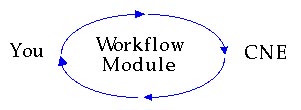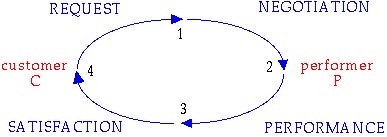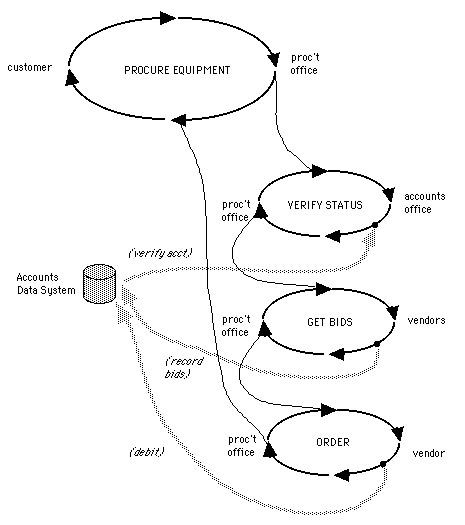Professional Services – Work Flow Systems
Workflow
systems can be described according to the type of process they are designed
to deal with. Thus we define three types of workflow systems:
Image-based
Workflow Systems
are designed to automate the flow of paper through an organization, by
transfering the paper to digital "images". These were the first
workflow systems that gained wide acceptance. These systems are closely
associated with "imaging" technology, and empathize the routing
and processing of digitized images.
Form-based
Workflow Systems are designed to intelligently route forms
thoughout an organization. These forms, unlike images, are text-based
and consist of editable fields. Forms are automatically routed according
to the information entered on the form. In addition, these form-based
systems can notify or remind people when action is due. This can provide
a higher level of capability than image-based workflow systems.
Coordination-based
Workflow Systems are designed to facilitate the completion
of work by providing a framework for coordination of action. The framework
is aimed to address the domain of human concerns (business processes),
rather than the optimization of information or material processes. Such
systems have the potential to improve organizational productivity by addressing
the issues necessary for customer satisfaction, rather than automating
proceedures that are not closely related to customer satisfaction.
Image-based
Workflow Systems
Workflow was initially closely associated with imaging, where workflow
software helped to automate image routing. In a typical scenario, incoming
mail (consisting of forms to be processed) is digitized and stored on
optical discs. The workflow software manages queues of pending documents,
automatically balancing the workloads of individual workers that are processing
the incoming forms.

A
case study of automating correspondence response to US X Telecom's customers.
X Telecom
receives correspondence from 80,000 to 100,000 of its phone customers
each month. Prior to implementing a workflow system from XTECH. for $X
million, it took 20-30 days to respond to a letter. After the implementation
of the system, the response time was cut to 5 days, with a 50% reduction
in staff and productivity improvements of 70%. X Telecom not only digitized
and routed the incoming correspondence, but accessed networked databases
and presented relevant information in CRM with the image. In some cases
the workflow system can place the appropriate information in a form letter
with no operator intervention.
Form-based
Workflow
Formed-based workflow takes image-baed workflow one step further. Rather
than simply routing images to workers, forms are routed. Since forms contain
data that is accessible to the workflow system, conditional decisions
can be made automatically by the workflow system. Thus routine forms might
have much of their data automatically filled in, while exceptions could
have complex rules for their processes.
An example
of how this form processing is done, and a comparison to imaging systems
is the following:
(Diogo Teixeira and Jeff Thompson's, 1993)
Banks
are a natural application area for image-based workflow systems, since
they still process enormous amounts of paper. This article gives an overview
of how banks are starting to use workflow software for the routing and
control of documents in the form of images. Workflow systems are described
that are concerned with the very high volume of clerical type work in
banks that is not routine enough to be processed automatically, but falls
into clearly definable categories so that there are a controllable number
of cases, outputs and options. It is clear that banks are starting to
see the advantage of transitioning to form-based workflow as well.
The authors
point out that it is almost impossible to make use of imaged documents
without implementing workflow software at the same time. Workflow software
is viewed as primarily a means for tracking and controlling documents.
The discussion
on workflow benefits from numerous references to how workflow is being
applied in collection systems, mail tracking systems and credit card processing,
among others.
Five
benefits are given for adopting workflow software:
1). There
is faster processing of work, since the total transaction time is generally
much greater than the time to complete the work steps
2) Workflow systems are usually based on the client-server architecture,
as opposed to mainframes
3) The information processes of the bank (the "work flows")
are made explicit and are more easily changed
4) Paper is eliminated
5) Financial losses from misprocessed paper are eliminated
Coordination-based
Workflow
Coordination-based workflow is grounded in the theory of communication
and coordination developed by Fernando Flores and Terry Winograd beginning
in the late 1970s (Flores 1979, Winograd and Flores 1987). Having proved
successful in a series of case studies, this theory is starting to emerge
as the basis of the new understanding of work.
Most human coordination occurs in the requesting, making, and fulfillment of commitments between people, and he proposed that the importance of the computer lies in facilitating this kind of coordination rather than simply in data processing. The basic cycle of coordination reappears at many levels of an organization, not just between individuals, and that the organization itself could be seen as a network of recurring workflow loops. In an accumulating series of case studies, it has become clear that the workflow-loop map is the basis for measurable and significant improvements in productivity and in satisfaction of customers and employees Although the workflow notation was invented for a commercial business context, it is much more general. It can be used to map coordinative processes among humans in any domain.

The above figure shows the generic structure of a coordination loop, called workflow. The notation supports an interpretation that work is a closed loop process in which a performer completes actions leading to the satisfaction of a customer's or client's request. During any phase, the participants may make requests of others, thus initiating secondary loops whose completion enables forward progress in the primary loop. This generates a network of connected loops: loop segments can be further refined, fractal-like, into more loops. A human coordinative process is a network of recurrent loops designed to carry out a specific function. An organization can be seen as a network of such processes that collectively carry out the organization's mission.

The above
figure shows, the map for a procurement process of an organization, illustrates
expansion into secondary workflows; in this case, the primary performance
phase is expanded into three sequential secondary loops. The figure also
illustrates a new notation that shows how client-server computing structure
interacts with the business process and affects its performance. In a
case study at George Mason University, we found that the process of student
advising cannot be made to have a fast turnaround unless the transcripts
of individual students are available on a moment's notice to a faculty
advisor during an advising session; to achieve the required response time,
the database must be mounted on a local server (Denning and Medina-Mora
1994).
The power
of this notation derives from two complementary aspects. First it explicitly
shows the actions leading to the satisfaction of an agreement between
two parties. Second, it shows direct connections between incompletions
of loops and breakdowns such as persistently dissatisfied customers, wasted
effort in complaint loops, lack of trust, or poor market credibility.
Figure 3 shows how a persistent incompletion in the primary loop of a
procurement process can give rise to a new secondary loop for complaint
resolution, which can further delay customer satisfaction and unnecessary
load to supporting computing servers. Case studies show that organizations
that persistently complete their loops on time will have many fewer of
these problems. Business process re-engineering can be significantly facilitated
with workflow-map notation that shows both the business process and client-server
computing systems (Denning and Medina-Mora, 1994).
The workflow map is explicitly concerned with the making and fulfilling of commitments, with determining who is responsible to carry out the work and by when, and with the satisfaction of the person making a request. These concerns place the organizational processes at a higher level of abstraction than the business, material and information processes of an organization -- the latter being the processes that move physical items and information items to various places where they are manipulated and combined. The more general organizational processes drive materiel and information processes. For this reason, tools for observing, measuring, and modeling material and information processes -- e.g., IDEF1 and Queueing Network Models -- are not powerful enough for building workflow systems oriented towards all organizational processes.
|
Copyright
- 2005 Xtech [DBE/MBE/WBE/LBE]
|
|
sales@xtechjv.com
866-XTECHJV (866-983-2458)
|